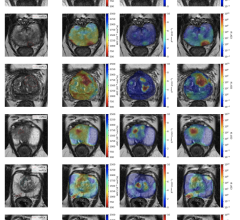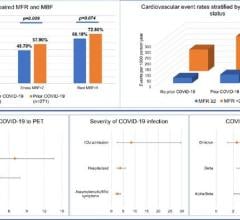
During the COVID-19 pandemic, many cardiology departments were faced with the daunting task of supporting inpatient and outpatient imaging needs, while still addressing ongoing patient safety concerns. Holston Valley Medical Center, the flagship hospital of Ballad Health’s Northwest Market in Kingsport, Tennessee, is consistently rated as a top cardiovascular hospital. Their cardiology department had a fairly stable pre-COVID volume of about 60 to 70 inpatient and outpatient studies per day. Their inpatient volume is closely tied to the hospital census, and when levels dropped in spring 2020 in anticipation of a potential COVID-19 surge, echo volume decreased along with it.
“We went from 30 inpatient studies down to single digits or barely double-digit days in the lab,” said cardiologist Ben Culp, M.D., FASE, RPVI, head of non-invasive imaging at the Ballad CVA Heart Institute. “It was very hard to predict or model, but it was all tied to the census.”
While inpatient volumes were dropping throughout the system, Ballad Health tried to maintain normal outpatient volumes. The community had not yet seen the same surge happening in much of the rest of the country, but the collective fear of COVID-19 kept many patients from coming in for procedures.
“We didn't want to delay necessary testing needlessly until we really had bigger risks,” Culp said. “We would schedule labor, schedule sonographers, have the appointment set, and then just have cancellation after cancellation.”
Once outpatient volumes dropped, many frontline staff had to be furloughed. Ballad Health is a merged health system, and over the past three years, it has been consolidating multiple cardiovascular operations into a single service line. In many ways, the drops in volume accelerated the consolidation process that was already happening.
“All of a sudden we shut down outpatient and inpatient services at one hospital and consolidated from two hospitals to one,” Culp said. “We shifted all the bandwidth over to one lab from three, and really shrunk our footprint, just to be able to function.”
This shutdown led to a significant outpatient backlog, as months of appointments were postponed or canceled. When it was deemed safe to resume operations, the department needed to identify a strategic and economical way to bring patients back to the clinic.
Making Informed Decisions During a Pandemic
Prior to the pandemic, Ballad Health was working with Philips on improving workflow and automating processes through a near-real-time dashboard to track image quality, productivity, turnaround time and volume.
“We had been looking at how to get our labs to be more efficient, our labor force to be more productive, and drive down our turnaround times,” Culp said. “COVID-19 really simplified what we were looking at, to where it was just overall volume. That's what we needed to know.”
Ballad Health was able to leverage these existing capabilities to analyze volume data within Philips IntelliSpace Cardiovascular and develop a clear pathway for using existing staff to help clear the backlog without a need for outside resources.
“When we started seeing backlogs accumulate on the outpatient side, within about two weeks, we had the data on our administrator’s desk of our backlogs and of our need to bring a sonographer back to keep the service line going,” Culp said.
Clearing the backlog quickly was a priority for hospital administration. East Tennessee has a high incidence of cardiovascular disease, and an echo or stress test is often the first step in getting patients access to more advanced therapies, which is a critical step in the pathway to wellbeing. For a patient anxious about a possible outcome, getting test results quickly is important.
“They’re going to be sitting at home waiting for that answer. The sooner you can give them that answer, the better. Just to ease their mind,” Culp said. “Getting things taken care of helps get them to the next step in their care. Any bottleneck stops that, so we want to keep that as efficient as possible.”
As part of their due diligence, Ballad Health investigated bringing traveling sonographers onboard to help with patient backlog, but the data analysis demonstrated it would be much more expensive than using their existing staff. And, the department needed a quick solution and the backlog continued increasing.
“We were maintaining pace for a few months, and with fewer techs, so it really did feel like more volume. We realized that our backlogs were getting worse and worse because we just couldn't handle the demand.”
Improving Staff Satisfaction in Challenging Situations
Ballad Health eventually began adding evening and weekend shifts for outpatient studies using their own technicians. About half of Ballad Health’s sonographers were interested in after-hours and extra shifts. They were able to negotiate an alternate pay rate that was more than overtime pay, but still less than the cost of bringing on traveling help. While the additional shifts meant long hours for technicians, Culp noted they appreciated the extra pay and he has heard positive staff feedback about the program.
“We started in January and we felt the improvement in February. And then in March, we really had that kick in for increased volume,” Culp said, “And that's helping us clear our backlogs quite a bit.”
Having access to the operational data made it easy to identify the most economical way to clear the backlog. The team was able to leverage existing data sets like physician throughput, modality availability and exam turnaround times, to demonstrate the revenue implications of clearing the backlog quickly by using existing staff.
The data “made us a lot more nimble. Where everybody else is restricting, we were trying to maintain,” Culp said. “The data sets gave us the ability to talk to our administrators when their bosses were telling them to cut back. We were able to say we have this need and we have to do it. It was a nice thing to have the data to back us up.”
Identifying Sources of Insight with the Right Workflow
The first step to developing an actionable data set like Ballad Health’s is to identify a clean data source. As they began looking at the various data inputs, such as the data in Philips IntelliSpace Cardiovascular and the Epic EMR, they found that the Philips IntelliSpace Cardiovascular information which includes data pulled directly from the Philips Ultrasound Cart, provided the most relevant data to strategically address the challenge.
“When you try to merge it all together, it can be a little bit harder to find the data,” said Puran Bhagat, principal systems architect for Philips who helped Ballad Health develop their data analysis dashboard. “When we used the Ultrasound Cart data along with Philips IntelliSpace Cardiovascular, it was much easier to identify opportunities. The sonographer was also used to enter the data, so this kind of analysis was easy to make.”
Over time, Ballad Health has trained technicians to input critical patient information at the point of care. This ingrained culture has made it easier to develop robust data sets that can be used for operational decision making.
“As long as you make a workflow where the tech can do it quickly and efficiently, and make it part of your culture, you actually get pretty good compliance with that, to the point that almost every single study has that,” Culp said. “Then you can sort it without much headache, because it's all in the same database. You don't have to deal with interfacing looking in other places. It might take the tech two extra seconds, but it saves so much on the back end, that it made it much more efficient.”
Lasting Improvements to Culture and Patient Care Using Cardiology Data
As departments return back to a new normal, Culp and Bhagat are looking for new ways to leverage the data they gather to benefit workflow and patient care. While COVID accelerated and simplified their data needs to a basic analysis of volume, now they’re beginning to look at more advanced drivers of workflow efficiency and productivity, like turnaround time and quality. For Culp, the key to a successful analytics program is ensuring data is easy to obtain, monitor and interpret.
“If you have a process that can track things, but you only do it one month a year because it's so time intense, then it's not sustainable,” Culp said. “If you bake something into the standard workflow that happens subconsciously, and you can make it efficient, then it becomes a sustainable commodity.”
Bhagat sees opportunities for this type of data analysis throughout the hospital ecosystem.
“The goal is to use this partnership and grow it to all areas of the hospital system,” Bhagat said. “We want to make sure we can get the most out of this engagement. Ballad leadership wants to take the best practices we have implemented and roll them into other sites as well.”
For more information: www.philips.com
Results from case studies are not predictive of results in other cases. Results in other cases may vary.


 March 20, 2024
March 20, 2024 









